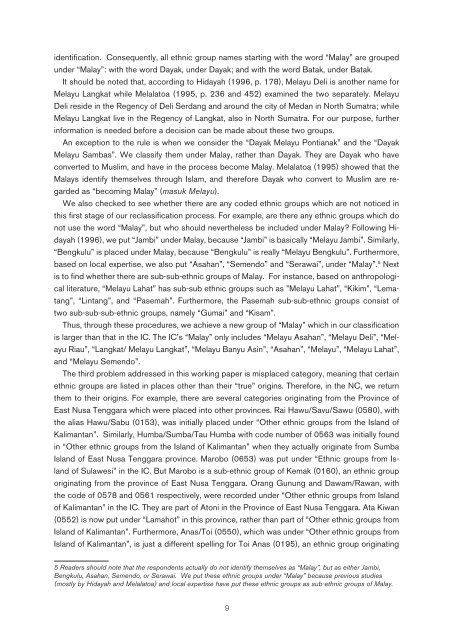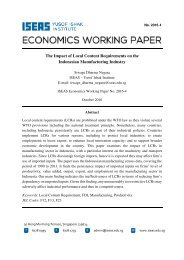1eM4IJR
1eM4IJR
1eM4IJR
Create successful ePaper yourself
Turn your PDF publications into a flip-book with our unique Google optimized e-Paper software.
identification. Consequently, all ethnic group names starting with the word “Malay” are grouped<br />
under “Malay”: with the word Dayak, under Dayak; and with the word Batak, under Batak.<br />
It should be noted that, according to Hidayah (1996, p. 178), Melayu Deli is another name for<br />
Melayu Langkat while Melalatoa (1995, p. 236 and 452) examined the two separately. Melayu<br />
Deli reside in the Regency of Deli Serdang and around the city of Medan in North Sumatra; while<br />
Melayu Langkat live in the Regency of Langkat, also in North Sumatra. For our purpose, further<br />
information is needed before a decision can be made about these two groups.<br />
An exception to the rule is when we consider the “Dayak Melayu Pontianak” and the “Dayak<br />
Melayu Sambas”. We classify them under Malay, rather than Dayak. They are Dayak who have<br />
converted to Muslim, and have in the process become Malay. Melalatoa (1995) showed that the<br />
Malays identify themselves through Islam, and therefore Dayak who convert to Muslim are regarded<br />
as “becoming Malay” (masuk Melayu).<br />
We also checked to see whether there are any coded ethnic groups which are not noticed in<br />
this first stage of our reclassification process. For example, are there any ethnic groups which do<br />
not use the word “Malay”, but who should nevertheless be included under Malay? Following Hidayah<br />
(1996), we put “Jambi” under Malay, because “Jambi” is basically “Melayu Jambi”. Similarly,<br />
“Bengkulu” is placed under Malay, because “Bengkulu” is really “Melayu Bengkulu”. Furthermore,<br />
based on local expertise, we also put “Asahan”, “Semendo” and “Serawai”, under “Malay”. 5 Next<br />
is to find whether there are sub-sub-ethnic groups of Malay. For instance, based on anthropological<br />
literature, “Melayu Lahat” has sub-sub ethnic groups such as ”Melayu Lahat”, “Kikim”, “Lematang”,<br />
“Lintang”, and “Pasemah”. Furthermore, the Pasemah sub-sub-ethnic groups consist of<br />
two sub-sub-sub-ethnic groups, namely “Gumai” and “Kisam”.<br />
Thus, through these procedures, we achieve a new group of “Malay” which in our classification<br />
is larger than that in the IC. The IC’s “Malay” only includes “Melayu Asahan”, “Melayu Deli”, “Melayu<br />
Riau”, “Langkat/ Melayu Langkat”, “Melayu Banyu Asin”, “Asahan”, “Melayu”, “Melayu Lahat”,<br />
and “Melayu Semendo”.<br />
The third problem addressed in this working paper is misplaced category, meaning that certain<br />
ethnic groups are listed in places other than their “true” origins. Therefore, in the NC, we return<br />
them to their origins. For example, there are several categories originating from the Province of<br />
East Nusa Tenggara which were placed into other provinces. Rai Hawu/Savu/Sawu (0580), with<br />
the alias Hawu/Sabu (0153), was initially placed under “Other ethnic groups from the Island of<br />
Kalimantan”. Similarly, Humba/Sumba/Tau Humba with code number of 0563 was initially found<br />
in “Other ethnic groups from the Island of Kalimantan” when they actually originate from Sumba<br />
Island of East Nusa Tenggara province. Marobo (0653) was put under “Ethnic groups from Island<br />
of Sulawesi” in the IC. But Marobo is a sub-ethnic group of Kemak (0160), an ethnic group<br />
originating from the province of East Nusa Tenggara. Orang Gunung and Dawam/Rawan, with<br />
the code of 0578 and 0561 respectively, were recorded under “Other ethnic groups from Island<br />
of Kalimantan” in the IC. They are part of Atoni in the Province of East Nusa Tenggara. Ata Kiwan<br />
(0552) is now put under “Lamahot” in this province, rather than part of “Other ethnic groups from<br />
Island of Kalimantan”. Furthermore, Anas/Toi (0550), which was under “Other ethnic groups from<br />
Island of Kalimantan”, is just a different spelling for Toi Anas (0195), an ethnic group originating<br />
5 Readers should note that the respondents actually do not identify themselves as “Malay”, but as either Jambi,<br />
Bengkulu, Asahan, Semendo, or Serawai. We put these ethnic groups under “Malay” because previous studies<br />
(mostly by Hidayah and Melalatoa) and local expertise have put these ethnic groups as sub-ethnic groups of Malay.<br />
9



